
Chusquea is a genus of evergreen bamboos in the grass family. Most of them are native to mountain habitats in Latin America, from Mexico to southern Chile and Argentina.
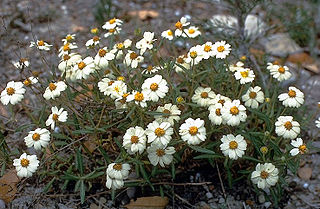
Melampodium is a genus of flowering plants in the sunflower family.

Zamia is a genus of cycad of the family Zamiaceae, native to North America from the United States throughout the West Indies, Central America, and South America as far south as Bolivia. The genus is considered to be the most ecologically and morphologically diverse of the cycads, and is estimated to have originated about 68.3 million years ago.

Tigridia, is a genus of bulbous or cormous flowering plants belonging to the family Iridaceae. With common names including peacock flowers, tiger-flowers or shell flowers, they have large showy flowers; and one species, Tigridia pavonia, is often cultivated for this. The approximately 35 species in this family grow in the Americas, from Mexico to Chile. The tigridia flower is short lived, each often blooming for only one day, but often several flowers will bloom from the same stalk. Usually they are dormant during the winter dry-season. The roots are edible and were eaten by the Aztecs of Mexico who called it cacomitl, and its flower ocēlōxōchitl "jaguar flower". The genus name Tigridia means "tiger-like", and alludes to the coloration and spotting of the flowers of the type species Tigridia pavonia.

Clethra is a genus of flowering shrubs or small trees described as a genus by Linnaeus in 1753.
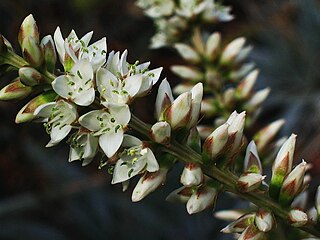
Hechtia is a genus of plants in the family Bromeliaceae, and is the sole genus of the subfamily Hechtioideae, containing 75 species. Its species are native to Mexico, Central America, and Texas.
Dalembertia is a plant genus of the family Euphorbiaceae first described as a genus in 1858. It is native to Mexico and Guatemala.
- Dalembertia hahnianaBaill. - México State, Morelos, Michoacán
- Dalembertia platanoidesBaill. - Oaxaca, Guerrero, México State
- Dalembertia populifoliaBaill. - from Sonora to Oaxaca
- Dalembertia triangularisMüll.Arg. - Guatemala, Chiapas, Oaxaca
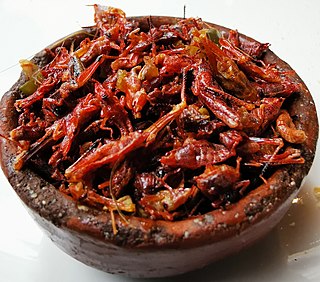
Chapulines, plural for chapulín, are grasshoppers of the genus Sphenarium that are commonly eaten in certain areas of Mexico. The term is specific to Mexico and Central America, and derives from the Nahuatl word chapolin[t͡ʃaˈpolin] (singular) or chapolimeh[t͡ʃapoˈlimeʔ] (plural).

Kinosternon is a genus of small aquatic turtles from the Americas known commonly as mud turtles.

Linnaea is a plant genus in the honeysuckle family Caprifoliaceae. Until 2013, the genus included a single species, Linnaea borealis. In 2013, on the basis of molecular phylogenetic evidence, the genus was expanded to include species formerly placed in Abelia, Diabelia, Dipelta, Kolkwitzia and Vesalea. However, this is rejected by the majority of subsequent scientific literature and flora.

Flaveria is a genus of plants in the family Asteraceae. They are sometimes called yellowtops. Some are annual or perennial herbs and some are shrubs. They bear yellow flowers in heads, with zero, one, or two ray florets in each head. These plants are found in the Americas, Asia, Africa, and Australia.
The Ixtlán deer mouse is a species of rodent in the family Cricetidae.

Telanthophora is a genus of Mesoamerican plants in the groundsel tribe within the daisy family.
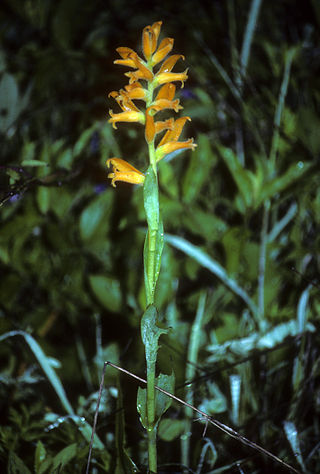
Dichromanthus is a genus of flowering plants from the orchid family, Orchidaceae. As currently delimited, it is monophyletic and includes four species:
- Dichromanthus aurantiacus(Lex.) Salazar & Soto Arenas - much of Mexico, south to Honduras
- Dichromanthus cinnabarinus(Lex.) Garay - from Texas to Guatemala
- Dichromanthus michuacanus(Lex.) Salazar & Soto Arenas - from Texas and Arizona south to Honduras
- Dichromanthus yucundaaSalazar & García-Mend. - Oaxaca

Rhynchostele is a genus of flowering plants from the orchid family, Orchidaceae, native to Mexico, Central America and Venezuela. The genus name is abbreviated as Rst. in the horticultural trade.
Berberis moranensis is a shrub in the genus Berberis in the family Berberidaceae. Because of its compound leaves, some botanists place it in the genus Mahonia. It is native to forested regions of the mountains of Mexico from Sinaloa and Guanajuato to Oaxaca. Berberis moranensis has thick waxy leaves, yellow flowers, and purple berries. This species is closely related to Berberis pimanaJ.E. Laferr. & J.S. Marr.
Thyrsanthemum is a genus of plants in the Commelinaceae, first described in 1946. The entire genus is endemic to Mexico.
Gibasoides is a genus of monocotyledonous flowering plants in the dayflower family, first described as a genus in 1978. The genus consists of a single species, Gibasoides laxiflora endemic to Mexico.
Matudanthus is a genus of monocotyledonous flowering plants in the dayflower family and was first described in 1978. The genus is monotypic and contains the single species Matudanthus nanus, which is endemic to the State of Oaxaca in southern Mexico.
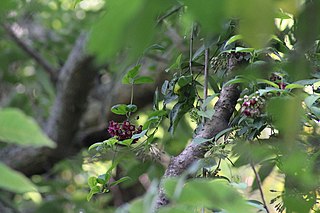
Thenardia is a genus of flowering plants in the family Apocynaceae, first described as a genus in 1819. It is native to Mexico and Honduras.













